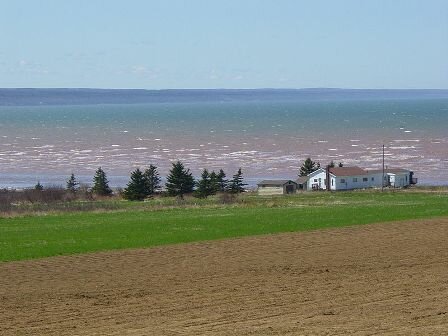If you love to travel around the world, then one of these following facts about the Bay of Fundy might be useful for your for your destination reference. The Bay of Fundy is a bay on the Atlantic coast of North America, on the northeast end of the Gulf of Maine between the Canadian province of New Brunswick and Nova Scotia, with a small portion touching the U.S. state of Maine. The Bay of Fundy is known for having the highest tidal range in the world. It also has one of the highest vertical tidal ranges in the world. For further information about this bay, here are some facts about the Bay of Fundy you might be interested in.
Facts about the Bay of Fundy 1: Name
Some sources believe the name “Fundy” is a corruption of the French word “Fendu”, meaning “split”,while others believe it comes from the Portuguese funda, meaning “deep”.The bay was also named Baie Francaise by explorer/cartographer Samuel de Champlain during a 1604 expedition led by Pierre Dugua, Sieur de Monts which resulted in a failed settlement attempt on St. Croix Island.
Facts about the Bay of Fundy 2: Wonders of Nature
In July 2009, the Bay of Fundy was named as a finalist for the New Wonders of Nature contest that ended in November 2011. It was not chosen as a wonder.
Facts about the Bay of Fundy 3: Tides
The Bay of Fundy is known for its high tidal range. The quest for world tidal dominance has led to a rivalry between the Minas Basin in the Bay of Fundy and the Leaf Basin in Ungaya Bay, over which body of water lays claim to the highest tides in the world, with supporters in each region claiming the record.
Facts about the Bay of Fundy 4: Mi’kmaq First Nation
Folklore in the Mi’kmaq First Nation claims that the tides in the Bay of Fundy are caused by a giant whale splashing in the water. Oceanographers attribute it to tidal resonance resulting from a coincidence of timing: the time it takes a large wave to go from the mouth of the bay to the inner shore and back is practically the same as the time from one high tide to the next.
Facts about the Bay of Fundy 5: Geology
The Bay of Fundy lies in a rift valley called the Fundy Basin; as the rift began to separate from mainland North America, volcanic activity occurred, forming volcanoes and flood basalts. These flood basalts poured out over the landscape, covering much of southern Nova Scotia. Sections of the flood basalts have been eroded away, but still form a basaltic mountain range known as North Mountain.
Facts about the Bay of Fundy 6: Saint John River
The bay’s extreme tidal range causes several interesting phenomena in the various rivers which empty into it. The Saint John River sees its flow reversed at high tide, causing a series of rapids at the famous Reversing Falls where the river empties into the bay, in a gorge in the middle of the city of Saint John.
Facts about the Bay of Fundy 7: Ports and Basins
The Bay of Fundy’s ports and basins became major shipbuilding and shipping centres in the 19th Century. Led at first by shipbuilders like James Moran of St. Martins, New Brunswick, shipbuilding to all shores of the Bay of Fundy and eventually included shipbuilders such as Joseph Salter in Moncton and William D. Lawrence of Maitland, Nova Scotia who build some of the larges sailing ships ever constructed in Canada.
Facts about the Bay of Fundy 8: Shipping Traffic
A result of shipping traffic has been the potential for increased collisions between ships and the North Atlantic right whale. In 2003, the Canadian Coast Guard adjusted shipping lanes crossing prime whale feeding areas at the entrance to the Bay of Fundy to lessen the risk of collision.
Facts about the Bay of Fundy 9: Parks
A number of parks preserve and interpret the Bay of Fundy’s coastal ecosystem. They include Fundy National Park in New Brunswick and Cape Provincial Park and Five Island Provincial Park and Blomidon Provincial Park.
Facts about the Bay of Fundy 10: National Wildlife Areas
The Canadian Wildlife Service maintains a number of National Wildlife Areas in the Bay of Fundy including a proposed designation of Isle Haute in the middle of the Bay.
Hope you would find those Bay of Fundy facts really interesting, useful and helpful for your additional reading.









